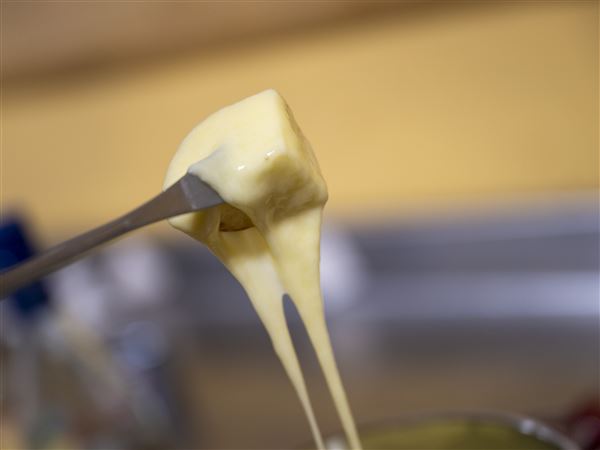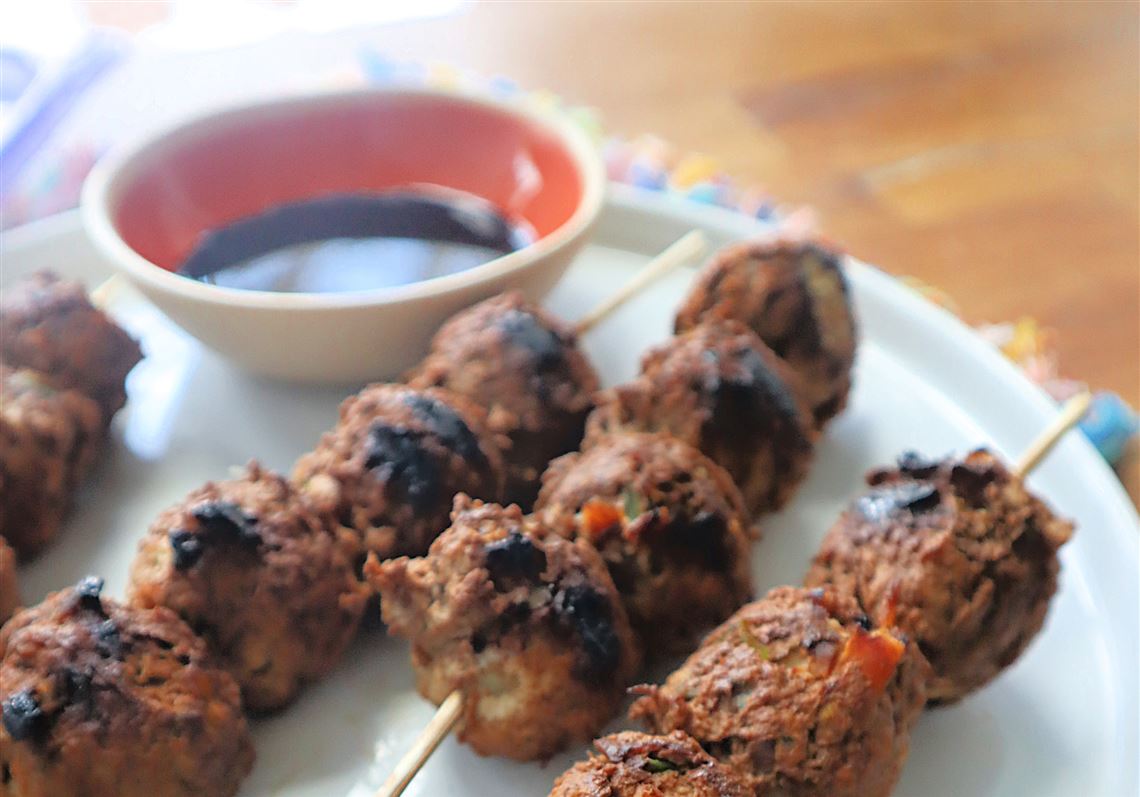The meatballs Americans know best are the ground beef, Italian variety that crowns a plate of spaghetti, or nestled with marinara and gooey cheese inside a crusty roll as a hoagie.
Yet so many other cultures across the globe love meatballs, too, even if they use different meats, spices and cooking methods to craft the ingredients into a delicious bite-sized nosh.
Depending on the cook and the favorite meat in the country of origin — lamb is a key ingredient in Mediterranean cuisine while pork rules supreme in Asia — meatballs can be fried, steamed, boiled, grilled or braised. Many are dipped in egg and flour and rolled in breadcrumbs to add a crispy outer layer; others are slowly simmered in a liquid or sauce for juicy tenderness.
The meat can be chopped, minced or even ground into a paste before being rolled into its prototypical rotund shape. Some don’t include meat at all but instead are built using grains like rice or quinoa and stuffed with a surprise filling like cheese or peas. Italian arancini, which are crafted with short-grain risotto rice and filled with cubes of mozzarella, are a perfect example.
What connects the meatballs of the world is a shared frugality born out of the practice of stretching a small amount of meat or other expensive ingredient into something that’s easy to cook, is extremely flavorful and offers nourishment for many.
Also, they’re just plain fun to eat.
These five recipes span the globe from Germany and Italy to China, Morocco and Japan. All are pretty easy to pull together using supermarket ingredients and simple techniques. If you can form a ball in the palm of your hand, you’ve got it!
Sauerkraut Balls
PG tested
These tasty meatballs are made with pork sausage and sauerkraut blended with herb cream cheese, breaded and deep-fried. They are thought to have originated in Akron, Ohio, where they’re a staple nosh on New Year’s Day in German-American households. They also make great football food.
It takes a minute to form the meatballs, and you really need to (gently) squeeze and roll them together. I served them with homemade Thousand Island dressing but they also pair well with a tangy mustard sauce.
Be sure to rinse and drain the sauerkraut; it can be really salty right out of the can!
1 pound pork sausage
¼ cup finely chopped onion
1 (14 ounce) can sauerkraut, well drained and finely chopped
2 tablespoons Italian seasoned dry bread crumbs
½ teaspoon prepared yellow mustard
¼ teaspoon garlic salt
⅛ teaspoon ground black pepper
4 ounces cream cheese, softened
2 tablespoons dried parsley flakes
¼ cup all-purpose flour
1 large egg, beaten
¼ cup milk
¾ cup Italian seasoned dry bread crumbs
Vegetable oil for frying, or as needed
Heat a large skillet over medium-high heat. Cook and stir sausage and onion until sausage is crumbly and browned, about 10 minutes. Drain grease and allow to cool slightly.
Transfer sausage mixture to a large bowl. Stir in drained sauerkraut, 2 tablespoons bread crumbs, mustard, garlic salt and pepper. Combine cream cheese and parsley in a small bowl; mix into sauerkraut mixture. Cover and refrigerate for 1 hour.
Place flour in a shallow bowl. Whisk together egg and milk in another bowl. Place ¾ cup bread crumbs in a third bowl.
Heat oil in a deep fryer or large saucepan to 375 degrees.
Shape sauerkraut mixture into ¾-inch balls. Coat balls in flour, then dip in egg mixture and roll in bread crumbs to thoroughly coat.
Working in batches, fry balls in hot oil until golden brown, 2-3 minutes. Drain on a paper towel-lined plate and serve hot.
After breading, the balls can be quick-frozen on a cookie sheet, then stored in freezer bags. They do not need to thaw before frying.
Makes 3 dozen balls
— pbswesternreserve.org
Mozzarella-stuffed Arancini
PG tested
A star of Italian street food, arancini — fried rice balls — are thought to have originated in Sicily in the 10th century, when the island was under Arab rule. They’re typically stuffed with fillings such as cheese or peas, coated in breadcrumbs and deep-fried. They can be eaten hot or at room temperature, with or without a dipping sauce.
It’s important to use short-grain, pearl-like Arborio rice because of its high starch content, which acts as a glue to bind all the ingredients together.
These arancini are stuffed with small cubes of fresh mozzarella. It helps to have slightly damp hands when forming the balls. I used regular dry bread crumbs because that’s what I had on hand; panko will result in a lighter crunch because it absorbs less oil when deep-frying.
For risotto
2 tablespoons extra virgin olive oil
1 small yellow onion, finely chopped
2 garlic cloves, crushed
1½ cups Arborio rice
1 teaspoon fine salt
⅛ teaspoon finely ground black pepper
3 tablespoons finely chopped Italian parsley leaves
3 cups chicken stock (store-bought or homemade)
2 teaspoons double-concentrated tomato paste
2 tablespoons unsalted butter
½ cup grated parmesan cheese
For stuffing
4 ounces mozzarella cheese
For coating
½ cup all-purpose flour
1 teaspoon fine salt
⅛ teaspoon finely ground black pepper
2 eggs
2 cups plain panko breadcrumbs
2 cups grapeseed or vegetable oil, for frying
Saute the onion and garlic: Add olive oil to a large, heavy-bottom saucepan; set on medium heat. Once the oil shimmers, add onion and garlic. Cook, stirring, until softened and fragrant, about 5 minutes.
Add rice to the saucepan and stir until semi-translucent, about 1 minute. Add salt, ground pepper, parsley, stock, tomato paste and butter.
Mix well and bring to a gentle boil. Reduce heat to low and cover with a lid. Let simmer until the rice is tender and the broth is absorbed, 20-25 minutes.
While the rice is cooking, grab 3 medium bowls. In one bowl, stir together the flour, salt and pepper. In the second, whisk the eggs. Add the breadcrumbs to the third bowl. Line two shallow baking sheets with parchment paper.
Cut the mozzarella into 18-20 ½-inch cubes and keep chilled and sealed in the refrigerator until ready to use.
When the rice is tender and the broth is fully absorbed, turn off the heat and stir in the parmesan. Carefully spread the rice onto one of the prepared baking sheets and let cool for 10 minutes.
When the rice is cool enough to handle, form it into 18 1-inch balls. You can do this with your hands or a small cookie scoop.
Once the balls are formed, insert a cube of cheese into the center and press the rice around it so the cheese is completely encased. (I found it easier to form the balls around the cheese cubes rather than sticking them into the middle.)
Carefully dredge each ball in flour, then egg, then breadcrumbs. Repeat until all the balls are completed and place each one on the other parchment-lined baking sheet.
In an 8-inch saucepan, heat 2 cups (approximately ½ inch deep) of oil to 350 degrees, or until the oil forms small bubbles but is not smoking.
Fry 6 balls at a time, turning gently until golden brown, about 3-4 minutes. Place completed arancini on a paper towel-lined plate.
Let cool for 5 minutes before serving stuck with toothpicks or with napkins on the side.
— themediterraneandish.com
Lion’s Head Meatballs
PG tested
These easy-to-make, tennis ball-sized meatballs are named for their shape and size — they resemble the head of a Chinese guardian lion, or foo dog. A classic celebration dish, they would be a perfect addition to your Lunar New Year celebration on Jan. 29.
Frying the meatballs in a wok before adding them to pan with the cabbage sets their shape, assuring they won’t fall apart during braising. The broth is meant to be light, but I found it really bland, so I added a couple dashes of soy sauce and about ½ cup of chicken broth.
You want fatty pork for flavor; don’t go leaner than a 80/20 blend or the meatballs will be dry. Also be gentle when forming them as overmixing the meat will make the meatballs less tender.
1 pound ground pork
2 tablespoons soy sauce
1 tablespoon Shaoxing wine or dry sherry
1 teaspoon grated ginger
1 teaspoon sesame oil
1 green onion, finely chopped
1 cup vegetable oil
½ pound Chinese (napa) cabbage
1 quart water
1 teaspoon kosher salt, plus more as needed
1 small bundle bean thread noodles, soaked in water to reconstitute
In large bowl, combine ground pork, soy sauce, wine, ginger, sesame oil and onions and mix very well. Divide the meat mixture into 6 portions and shape each into a meatball.
Preheat a wok over high heat until wisps of smoke rise from the surface. Add the oil and heat until it begins to shimmer. Using a slotted spoon, gently lower 3 meatballs into the oil.
Brown meatballs for 2-3 minutes on each side, adjusting heat as needed. (You don’t need to cook them all the way through.) Transfer to a dinner plate and repeat with remaining meatballs.
Core the cabbage, leaving the inner leaves whole. Cut the larger, outer leaves into segments.
In a Dutch oven large enough to hold all the meatballs, add cabbage leaves and place the browned meatballs on top of cabbage. Add water and bring to a boil over high heat.
Reduce heat to low. Simmer for about 45 minutes, uncovered, or until the broth tastes delicious and the cabbage has cooked down.
Stir in the salt, adding additional to taste, if necessary. Submerge the noodles in the broth and let them soften for about 5 minutes.
Serve with rice as part of a meal.
Serves 4-6.
— adapted from “Chinese Soul Food” by Hsiao-Ching Chau
Kefta Tagine with Herbs, Spices and Lemon
PG tested
In Morocco, where this dish originated, kefta are often shaped into kebabs made with ground beef or lamb. Here, they’re formed into olive-sized meatballs that are poached in a fragrant sauce. But the flavor is the same, with warm Mediterranean spices such as cumin, paprika, coriander and cinnamon bringing out a rich flavor.
To make saffron water, gently grind a pinch of saffron threads (around 10 strands) with a pinch of sugar or salt using a mortar and pestle. Place in a small cup, add 1 cup of hot (but not boiling) water and allow the mixture to steep for at least 10-15 minutes.
I used ground beef, and added a pinch too much cayenne, which made for one spicy meatball!
Kefta is traditionally made in a tagine, a North African cooking pot with a wide, shallow base and a conical lid that can be used for both cooking and serving. I used a Dutch oven and it turned out just as well.
For kefta
1 pound lean ground beef or lamb
3 tablespoons creme fraiche
2 teaspoons sweet paprika
1 teaspoon ground cumin
1 teaspoon ground coriander
¼ teaspoon ground cinnamon
¼ teaspoon grated nutmeg
¼ teaspoon cayenne
Salt and pepper
2 tablespoons chopped flat-leaf parsley
2 tablespoons chopped cilantro
For sauce
1 medium red onion, grated
2 tablespoons unsalted butter
¼ cup saffron water
1 teaspoon sweet paprika
½ teaspoon ground cumin
¼ teaspoon ground ginger
¼ teaspoon ground black pepper
2-3 pinches cayenne
Pinch of ground turmeric
½ teaspoon salt
1 cup chopped cilantro, divided
2 tablespoons fresh lemon juice
White rice or naan, for serving
Make kefta: Combine all ingredients in a food processor. Blend until pasty. Form into 24 olive-sized balls. Refrigerate until ready to use.
Make sauce: Set a tagine or Dutch oven over medium-low heat. Add grated onion, butter, saffron water, spices, salt, ¾ cup cilantro and ½ cup hot water.
Slowly raise the heat to bring it to a boil, then reduce heat to medium and cover. Simmer gently to blend the flavors, about 10 minutes.
Add the kefta and poach, covered, for 30 minutes, turning them midway.
Add lemon juice and correct the seasoning with salt and pepper. Transfer to a serving plate and garnish with remaining cilantro, with toasted bread for mopping.
Serves 4.
Serve with white rice or warm naan or flatbread, for dipping.
— “The Food of Morocco” by Paula Wolfert
Tsukune no Teriyaki
PG tested
These tasty grilled Japanese meatballs are made with ground chicken studded with green onion. The hardest part of the recipe might be finding the mountain yam — also known as yamaimo and Chinese yam — that lends a lovely, silky texture. Popular in Japanese cuisine for their sticky texture, the elongated, cylindrical tubers help bind the ingredients together.
Tsukune are a popular street food in Japan, where they are often cooked on a skewer over live coals and brushed with a tare made from soy sauce, mirin, brown sugar and sake. I used jarred teriyaki and cooked the skewers on a cast-iron grill pan.
1 pound dark meat ground chicken
¼ cup finely chopped scallions (white and green parts)
¼ cup finely grated peeled Chinese yam
2 tablespoons minced ginger
1 tablespoon sake
½ teaspoon kosher salt
2 large egg yolks
Ground white pepper, to taste
Vegetable oil, for grill grates
½ cup teriyaki sauce
Bring a large pot of water to boil.
Combine ground chicken, scallions, yam, ginger, sake, salt, egg yolks and white pepper in a small mixing bowl.
Firmly mix with your hands until the ingredients are well distributed — it will be much looser than for the typical Western meatball.
Form mixture by the tablespoon into 1½-inch meatballs in the palm of your hand (I used a small cookie scoop).
Add them to the boiling water and cook until the meatballs are cooked through (they will float to the surface and be firm to the touch), 6-8 minutes.
Use a slotted spoon to transfer meatballs to a paper towel-lined plate. You can either grill them right away or let them chill, covered, in the fridge for up to 2 days; let them come up to room temperature before cooking.
Prepare grill to cook over medium-high heat and lightly rub the grill grates with vegetable oil. (I used a cast-iron stove-top grill.)
Skewer the meatballs (about 3 per skewer) so that the bottom 2 inches are empty and the tip barely sticks out from the top.
Generously brush the meatballs with teriyaki sauce and grill, turning over once and occasionally brushing with sauce, until they are lightly charred, about 3 minutes. Serve immediately.
Makes about 18 meatballs.
— “Mastering the Art of Japanese Home Cooking” by Masaharu Morimoto
First Published: January 14, 2025, 12:05 p.m.
Updated: January 14, 2025, 8:35 p.m.






















